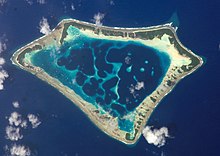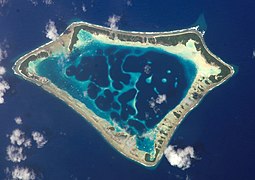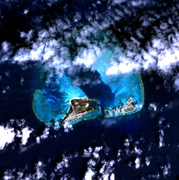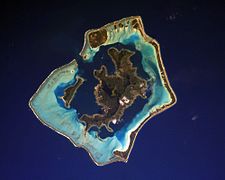Atoll
An atoll is an oceanic coral island, generally in the shape of a more or less circular ring, or it is also understood as the set of several small islands that form part of a coral reef, with an interior lagoon that communicates generally with the sea. Atolls form when a coral reef grows around a volcanic island as the island sinks into the ocean. Because it is an island made up mostly of coral, which forms a favorable habitat for ocean life, the diversity of fish that inhabit it is considerably large. Most of them are found in the Pacific Ocean, although there are also some in the Indian Ocean and, only in the Caribbean Sea, a few in the Atlantic Ocean, it should be noted that the latter are close to the coast. There are some that have an island in the middle, like Bora Bora, and Wallis, so they can be considered as islands/atolls.
Use
The word atoll comes from Dhivehi (an Indo-Aryan language spoken in the Maldives) === > atholhu. The first written record of this word is from 1625. However, the term was popularized by Charles Darwin (1842, p. 2), who described atoll as a subset in a special class of islands, whose distinctive feature is the presence of an organic reef. More modern definitions of an atoll are those of Fairbridge (1950), who defines it as a ring-shaped reef that includes a lagoon in the center, and that of Patrick D. Nunn, who gives a good explanation of the formation of atolls, although somewhat contradictory since it indicates that they are due to the collapse of the old volcanoes-islands to later point out that they are due to the rise in sea level, this increase being a consequence of the collapse of the volcanic relief itself.
Formation of an atoll

Darwin published an explanation of the formation of coral atolls in the South Pacific (1842) based on observations made during his five-year voyage aboard HMS Beagle (1831-36). His explanation, which is still accepted as basically correct, involves the consideration that various types of tropical islands—starting with the highest volcanic islands, continuing with barrier reefs, and ending with atolls—represent a sequence of subsidence (subsidence) gradual from what began as an oceanic volcanic cone. Darwin reasoned that a coral reef developed around a volcanic island in the tropical ocean would grow upward as the island subsided, eventually forming a great coral reef, such as that represented, for example, by Bora Bora. This occurs because the outer part of the bank maintains itself close to sea level due to its biotic growth, while the inner part of the bank lags behind in its growth, giving rise to a lagoon, because the conditions inside are less favorable. for corals and calcareous algae, responsible for most of the reef growth. During this process, the collapse leads the old volcano to be below sea level, but not the coral banks, which do not stop growing while the island sinks, maintaining maximum biological activity where conditions are optimal., flush with the water. At this point, the island that was born as a volcanic cone has become an atoll, a ring-shaped coral island. On ancient coral islands, the struggle between coral subsidence and upward growth is interrupted when the rate of that subsidence greatly exceeds the rate of coral growth out of the water. This happens when erosion acts with greater intensity, lowering the coral surface below the direct action of the sun's rays, which endangers its very existence as an island.
Because atolls are the growth of tropical marine organisms, these islands are only found in warm waters in the tropics. Volcanic islands located beyond the areas where the water temperature is suitable for the growth of marine organisms that form corals, sink and are eroded on the surface. An island that is located where the ocean temperature is just warm enough for the growth of the rising coral ring to compensate for the subsidence is said to be at Darwin Point. The more polar islands develop towards seamounts or guyots; the more equatorial islands develop into atolls (eg Kure Atoll).
Reginald Aldworth Daly offered a somewhat different explanation for atoll formation: they would be islands worn away by erosion (sea waves and ocean currents) during the last retreat of sea level (occurring in the ice age) of about 100 meters below present sea level that developed as coral islands (atolls) (or coral reefs on a shelf surrounding a not completely eroded volcanic island) when sea level gradually rose as glaciers melted. The discovery of the great depth of the volcanic remnant under many atolls favors Darwin's explanation, although there can be little doubt that fluctuating sea level has had a considerable influence on the atolls.
Layout and size
Most of the world's major atolls are in the Pacific Ocean (with concentrations in the Tuamotu Archipelago, the Caroline Islands, the Marshall Islands, the Coral Sea, and the Kiribati and Tuvalu island groups) and in the Indian Ocean (the atolls of the Maldives, the Laccadive Islands, the Chagos Archipelago and the outer islands of the Seychelles).
In the Atlantic Ocean is the Atoll de las Rocas, belonging to Brazil. In the Caribbean, which can be considered as a part of the Atlantic, there are eight atolls (Alburquerque, Bajo Nuevo, Quitasueño, Roncador, Serrana, Serranilla...) of the Archipelago Department of San Andrés and Providencia in the northwest of Colombia near the coasts Nicaraguan. Venezuela also has numerous coral islands and the Los Roques archipelago constitutes an extensive atoll whose relief of volcanic origin has been sinking until leaving only rocky vestiges, precisely on the easternmost island, Gran Roque.
As a note, reef-building corals can only thrive in warm tropical and subtropical oceans and seas, and therefore atolls are only found in the tropics and subtropics. The northernmost atoll in the world is Kure Atoll at 28°24′N 178°20′W / 28.400, -178.333, with other atolls in the Hawaiian Islands of the northwest. The southernmost atolls in the world are Elizabeth Reef at 29°57′25″S 159°4′32″E / -29.95694, 159.07556, and near Middleton Reef at 29°27′28″S 159°7′7″E / -29.45778, 159.11861, in the Tasman Sea, both part of the Territory of the Islands of the Coral Sea. The next southern atoll is Ducie Island in the Pitcairn Islands, at 25°04′00″S 130°06′00″W / -25.06667, -130.10000. Bermuda is sometimes identified as "the northernmost atoll" at a latitude of 32°20′00″N 64°45′00″W / 32.33333, -64.75000. At this high latitude these coral reefs would not have developed were it not for the warm waters of the Gulf Stream. However, Bermuda is called a pseudo-atoll because although its general shape resembles that of an atoll, it has a very different mode of formation. And the same could be said of the Florida Keys and, above all, of the Bahamas, which has been a kind of combination between atolls and barrier reefs. While there are no atolls directly on the Equator, the closest atoll to the Equator is Kiribati's Aranuka, with its southern tip only 12 km from the Equator.
In terms of total area (lagoon plus reef), the largest atolls are in the Maldives, such as Huvadhoo Atoll, with an area of 2,670 km²; the area of Thiladhunmathi and Miladhunmadulu Atolls (two names, but one structure) is even larger at 3,680 km². Other notable atolls are the Lihou Reef in the Coral Sea, with a 2,500 km² lagoon, and the Javanese Ontong Atoll. However, the largest structure in the world is the Greater Chagos Bank in the Indian Ocean, most of which is submerged, the part of the Chagos Islands, with an area of approximately 13,000 km². Kwajalein in the Marshall Islands, which is sometimes listed as the world's largest atoll (the largest in the Pacific Ocean), measures just 846 km². Large atolls are also found in the Tuamotu archipelago, the largest being Rangiroa, with a 1,018 km² lagoon.
In most cases, the land portion of an atoll is very small compared to the total area. The largest atoll in the world in terms of "portion of land" (the land "permanently" above sea level) is Kiritimati (321.37 km² of land; according to other sources 575 km²), 160 km² main lagoon, 168 km² other lagoons (according to other sources 319 km² total lagoon size). The remains of an ancient atoll in the shape of a hill in a limestone area is known as a reef butte.
List of Atolls
Here is a list of several relevant atolls:
- Bora Bora, French Polynesia
- Mururoa, French Polyensia
- Atolón Palmira, United States
- Atolon Wallis, Wallis and Futuna
- Atolón Midway, United States
- Atolon Bikini, Marshall Islands
Atolls Image Gallery
Note: Cosmoledo and Astove atolls are part of the Aldabra group of the Seychelles islands.
Contenido relacionado
Department of Moquegua
Maine
Iowa















